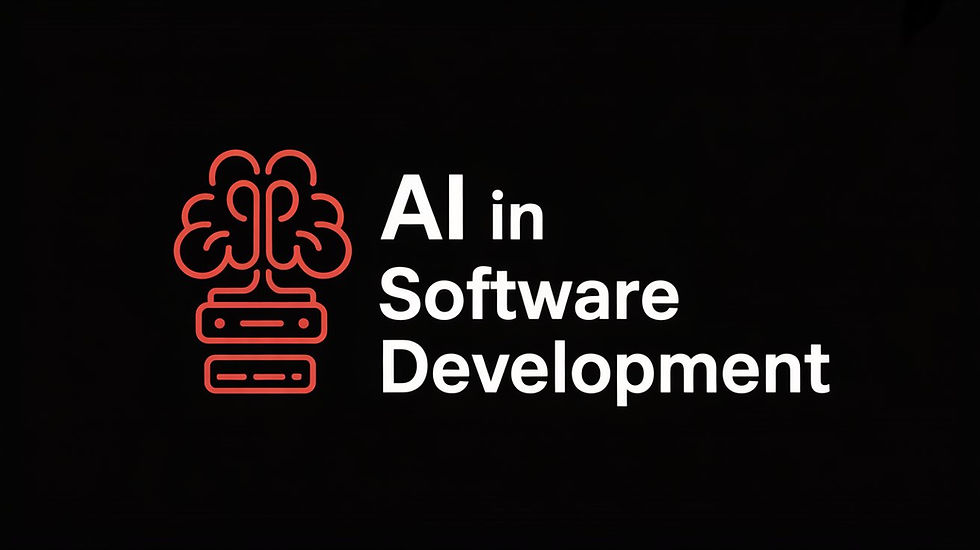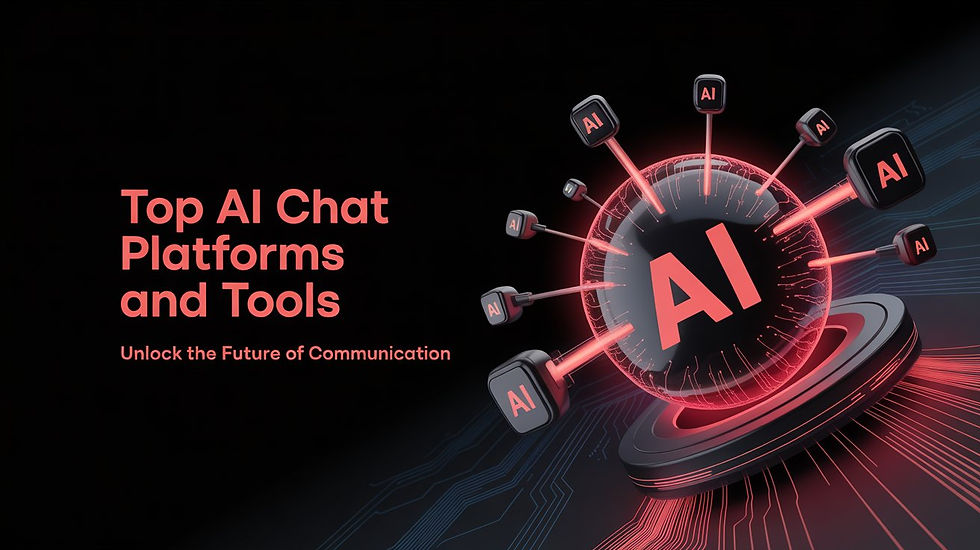AI Digital Transformation Strategy for Business: 2025 Trends and Tools
- pengarhehe
- Aug 12
- 6 min read

AI Digital Transformation
In 2025, forward-thinking companies view artificial intelligence as the cornerstone of digital transformation. AI-driven strategies “fundamentally transform” traditional business practices by enabling predictive analytics, automated efficiency, and hyper-personalized customer experiences. Gartner research predicts that AI will “drive a significant shift in digital commerce” focused on customer centricity by 2030, underscoring how central AI has become to competitive strategy. By strategically integrating AI across products, processes, and culture, businesses can create more agile, data-driven organizations capable of rapid innovation.
Digital transformation powered by AI isn’t just a buzzword – it means systematically using machine learning, automation, and data science to reinvent operations end-to-end. It often starts with collecting high-quality data and choosing clear objectives. For example, companies like Amazon use AI to anticipate stock shortages and reroute deliveries in real time, dramatically boosting supply chain efficiency. Netflix similarly leverages machine learning on viewing data to personalize content and drive engagement. These cases show that AI lets organizations learn from data as they go, turning historical insights into real-time decisions.
To succeed, businesses must address four key areas: strategy, data/infrastructure, governance, and culture. For instance, HBS research emphasizes that combining “digital networks, AI, machine learning” expands strategic options. Below are essential focus areas for an AI-powered transformation:
Define a Clear Strategy: Align AI projects with overarching business goals. Determine where AI will add value – whether in boosting sales, improving service, or optimizing costs. As experts note, modern strategy “continuously evolves by leveraging advanced technologies” like AI.
Ensure Robust Infrastructure: Invest in scalable, cloud-based systems and quality data. A well-designed digital architecture – with interconnected platforms and real-time data flows – is critical so AI tools can access and analyze information seamlessly. For example, GE implemented cloud-connected sensors and AI analytics to predict equipment failures before they occur. Without this foundation, AI models can’t train effectively or deliver reliable insights.
Implement Data Governance: Establish policies and governance to manage risk, privacy, and ethics. As AI integrates deeply, organizations must handle data responsibly. Harvard notes that strong governance provides structures and processes to prevent unintended consequences like security vulnerabilities or algorithmic bias. In practice, this means auditing AI inputs/outputs and ensuring transparency.
Foster an AI-Friendly Culture: Cultivate a growth mindset and cross-functional collaboration. Digital transformation often fails when teams operate in silos. Microsoft’s CEO Satya Nadella, for example, shifted the company culture by breaking down silos and emphasizing a “growth mindset” as AI tools provided data-driven insights for faster decisions. Leadership buy-in and employee training are vital; people should feel empowered to use AI tools as part of their workflows.
Transformative AI Use Cases in 2025
Businesses across every industry are applying AI in groundbreaking ways. Here are key use cases showing why AI is central to modern digital strategy:
Marketing & Sales: AI enables smarter campaigns and personalization. Many marketing SaaS platforms now embed machine learning to improve targeting. For instance, email marketing services like GetResponse and AWeber use AI to optimize send times and subject lines for higher open rates. AI models can also score leads and recommend next steps: predictive analytics identify which prospects are most likely to convert, letting sales teams focus on high-value opportunities. Additionally, content creation is being reshaped by AI: tools can suggest blog topics, draft ad copy, or generate product descriptions in seconds, freeing marketers to refine strategy instead of writing manual drafts.
Customer Service & Support: AI-powered chatbots and virtual assistants are now standard. Platforms like LiveChat offer AI bots that handle routine inquiries and even schedule appointments, providing 24/7 support. According to industry reports, AI chatbots can significantly cut response times and support costs by answering FAQs or routing complex issues to human agents with suggested solution. For example, an e-commerce site might deploy a chatbot to instantly recommend products or process simple returns without human intervention, improving customer satisfaction.
Operations & Supply Chain: In operations, AI drives efficiency and resilience. For example, logistics firms use machine learning to optimize routes and inventories. The same Amazon case shows this: by analyzing real-time data, Amazon’s AI systems predict demand spikes and automatically adjust shipments. Manufacturers use AI for predictive maintenance – sensors feed equipment data into AI models that flag anomalies, preventing breakdowns. As a result, factories and warehouses operate more smoothly with minimal downtime.
Business Intelligence & Analytics: AI dramatically enhances analytics. Rather than waiting for quarterly reports, executives can tap AI tools for real-time insights. AI-driven analytics modules automatically detect trends or anomalies in data. For instance, advanced SaaS dashboards can highlight a plummeting sales segment or foresee customer churn before it happens. This allows teams to proactively refine strategies – like reallocating marketing spend or revising product features – rather than reacting to stale numbers.
Each of these use cases highlights a common theme: AI turns static processes into continuous learning loops. Machines learn from new data and optimize over time. The democratization of AI via cloud SaaS means even small businesses can access these capabilities on subscription, accelerating their digital maturity.

Leading AI Tools and Platforms
A vibrant ecosystem of AI-powered tools exists to support these transformations. Many of today’s business platforms come AI-enabled by default, and specialized tools can be adopted as needed:
Email & Marketing Automation: Services like ActiveCampaign and MailerLite offer advanced workflows with AI-driven personalization. These platforms can trigger email campaigns based on user behavior, segment audiences automatically, and recommend next-step content. Combined with AI-optimized email solutions like GetResponse and AWeber, businesses can nurture leads at scale.
Content Creation: AI writing tools are booming. Solutions like Scalenut, WriteSonic Botsonic, and VeryGoodCopy generate articles, social posts, or ad copy in minutes. They use deep learning to craft drafts based on minimal input. For designers and videographers, tools like Canva’s AI assistant or emerging platforms can quickly produce images, graphics, or video outlines from text prompts. Using these tools, teams dramatically shorten time-to-content without sacrificing quality.
Chatbots & Virtual Assistants: Beyond marketing, dedicated chatbot platforms like Chatbot.com let businesses deploy sophisticated AI agents on their websites or messaging apps. These services often include intuitive builders requiring no code, so even non-technical staff can configure bots for sales, booking, or FAQs. In addition, customized AI agents built on frameworks (for example CustomGPT) allow companies to train models on their proprietary data, effectively creating a bespoke AI “consultant” for internal processes.
Voice & Video: AI is also transforming media. ElevenLabs and Fliki provide realistic text-to-speech engines and video creation, enabling quick production of narrated demos, training videos, or marketing clips. These tools lower barriers to rich content – for example, a product team can input a product script and instantly get a video demo with lifelike voiceover. For YouTube creators and marketers, plugins like TubeBuddy use AI to suggest titles, tags, and posting schedules that boost SEO and engagement.
Productivity & Integration: Other platforms like Everneed AI, Systeme.io, and Make.com (formerly Integromat) apply AI to workflow automation. They can automatically organize emails, schedule tasks, or integrate disparate apps. For example, an AI-powered workflow could analyze leads from CRM and set calendar reminders, so nothing falls through the cracks. Leveraging low-code/no-code AI platforms means smaller teams can still orchestrate complex automations without heavy IT overhead.
These tools illustrate that AI in 2025 is not a one-off project but a suite of capabilities embedded across marketing, operations, and IT. By choosing the right mix of AI services – from chatbots to content generators – businesses multiply their effectiveness.
Frequently Asked Questions
What is AI-driven digital transformation?
A: AI-driven digital transformation refers to the strategic use of artificial intelligence (machine learning, automation, analytics, etc.) to fundamentally change how a business operates and delivers value. It means leveraging AI across products and processes so that operations become more data-driven, automated, and adaptive. In practice, it might involve using AI for personalized marketing, automated customer support, predictive maintenance in factories, and more.
How do I develop an AI transformation strategy?
A: Start by defining clear business goals for AI (e.g., improve customer experience or cut costs). Next, audit your data and tech infrastructure – AI needs quality data and cloud/compute resources. Build the strategy around prioritized use cases (marketing, sales, support, etc.) and ensure you have leadership buy-in. Invest in data governance and staff training. Finally, choose incremental pilot projects to show quick wins, measure ROI, and iterate. Document lessons learned and scale successful AI projects across the company.
What are examples of AI tools for marketing?
A: There are many AI tools for marketing automation, content, and analytics. Email platforms like GetResponse and AWeber use AI to optimize sends and personalization. AI writing assistants (e.g. Scalenut or WriteSonic) generate ad copy and blog drafts. Chatbot services (e.g. LiveChat) handle customer queries. Analytics tools with AI can identify trends or customer segments automatically. Selecting tools depends on your needs – many SaaS products now bundle AI by default.
Why is E-E-A-T important for AI content?
A: Google’s algorithms and quality raters favor content that demonstrates Experience, Expertise, Authoritativeness, and Trustworthiness AI tools can generate text, but ensuring E-E-A-T means the content should be fact-checked by experts, cite credible sources, and be useful to humans. In practice, this means writing naturally (not robotic jargon), including real data/examples (with citations like we have here), and keeping content up-to-date. This builds trust with readers and signals to Google that your page deserves a high rank.
How will generative AI shape the future of digital transformation?
A: Generative AI is expected to have a huge impact. It enables machines to create original content – for example, automatically generating marketing images, product prototypes, or even code snippets. This greatly speeds up innovation: as one tech analysis points out, generative AI lets businesses “rapidly develop new products, personalize experiences, and automate routine tasks”. In the future, businesses will use generative models embedded in their workflows, turning creative jobs into more strategic, oversight roles.





Comments